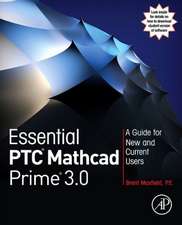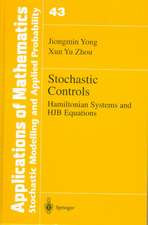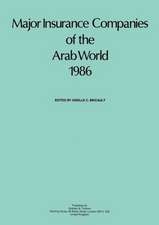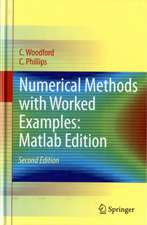Monte Carlo Methods in Financial Engineering: Stochastic Modelling and Applied Probability, cartea 53
Autor Paul Glassermanen Limba Engleză Paperback – 19 noi 2010
This book develops the use of Monte Carlo methods in finance and it also uses simulation as a vehicle for presenting models and ideas from financial engineering. It divides roughly into three parts. The first part develops the fundamentals of Monte Carlo methods, the foundations of derivatives pricing, and the implementation of several of the most important models used in financial engineering. The next part describes techniques for improving simulation accuracy and efficiency. The final third of the book addresses special topics: estimating price sensitivities, valuing American options, and measuring market risk and credit risk in financial portfolios.
The most important prerequisite is familiarity with the mathematical tools used to specify and analyze continuous-time models in finance, in particular the key ideas of stochastic calculus. Prior exposure to the basic principles of option pricing is useful but not essential.
The book is aimed at graduate students in financial engineering, researchers in Monte Carlo simulation, and practitioners implementing models in industry.
Mathematical Reviews, 2004: "... this book is very comprehensive, up-to-date and useful tool for those who are interested in implementing Monte Carlo methods in a financial context."
| Toate formatele și edițiile | Preț | Express |
|---|---|---|
| Paperback (1) | 402.94 lei 3-5 săpt. | +42.31 lei 6-12 zile |
| Springer – 19 noi 2010 | 402.94 lei 3-5 săpt. | +42.31 lei 6-12 zile |
| Hardback (1) | 464.60 lei 3-5 săpt. | +40.57 lei 6-12 zile |
| Springer – 7 aug 2003 | 464.60 lei 3-5 săpt. | +40.57 lei 6-12 zile |
Din seria Stochastic Modelling and Applied Probability
- 17%
 Preț: 464.60 lei
Preț: 464.60 lei - 18%
 Preț: 805.44 lei
Preț: 805.44 lei - 18%
 Preț: 1110.72 lei
Preț: 1110.72 lei - 18%
 Preț: 947.35 lei
Preț: 947.35 lei -
 Preț: 390.84 lei
Preț: 390.84 lei - 18%
 Preț: 952.40 lei
Preț: 952.40 lei - 15%
 Preț: 648.56 lei
Preț: 648.56 lei - 18%
 Preț: 951.91 lei
Preț: 951.91 lei - 15%
 Preț: 637.13 lei
Preț: 637.13 lei - 18%
 Preț: 793.63 lei
Preț: 793.63 lei -
 Preț: 391.02 lei
Preț: 391.02 lei -
 Preț: 401.42 lei
Preț: 401.42 lei - 15%
 Preț: 639.08 lei
Preț: 639.08 lei - 18%
 Preț: 733.33 lei
Preț: 733.33 lei - 18%
 Preț: 785.11 lei
Preț: 785.11 lei - 15%
 Preț: 593.42 lei
Preț: 593.42 lei - 18%
 Preț: 1114.96 lei
Preț: 1114.96 lei - 15%
 Preț: 643.16 lei
Preț: 643.16 lei -
 Preț: 390.63 lei
Preț: 390.63 lei - 15%
 Preț: 645.60 lei
Preț: 645.60 lei - 15%
 Preț: 641.71 lei
Preț: 641.71 lei - 18%
 Preț: 954.62 lei
Preț: 954.62 lei - 15%
 Preț: 645.14 lei
Preț: 645.14 lei - 18%
 Preț: 947.50 lei
Preț: 947.50 lei - 18%
 Preț: 804.96 lei
Preț: 804.96 lei - 15%
 Preț: 644.63 lei
Preț: 644.63 lei - 20%
 Preț: 469.59 lei
Preț: 469.59 lei - 20%
 Preț: 581.39 lei
Preț: 581.39 lei
Preț: 402.94 lei
Nou
Puncte Express: 604
Preț estimativ în valută:
77.10€ • 80.34$ • 63.84£
77.10€ • 80.34$ • 63.84£
Carte disponibilă
Livrare economică 13-27 martie
Livrare express 26 februarie-04 martie pentru 52.30 lei
Preluare comenzi: 021 569.72.76
Specificații
ISBN-13: 9781441918222
ISBN-10: 1441918221
Pagini: 612
Ilustrații: XIII, 596 p. 4 illus.
Dimensiuni: 155 x 235 x 35 mm
Greutate: 0.84 kg
Ediția:Softcover reprint of hardcover 1st ed. 2003
Editura: Springer
Colecția Springer
Seria Stochastic Modelling and Applied Probability
Locul publicării:New York, NY, United States
ISBN-10: 1441918221
Pagini: 612
Ilustrații: XIII, 596 p. 4 illus.
Dimensiuni: 155 x 235 x 35 mm
Greutate: 0.84 kg
Ediția:Softcover reprint of hardcover 1st ed. 2003
Editura: Springer
Colecția Springer
Seria Stochastic Modelling and Applied Probability
Locul publicării:New York, NY, United States
Public țintă
GraduateCuprins
1 Foundations.- 2 Generating Random Numbers and Random Variables.- 3 Generating Sample Paths.- 4 Variance Reduction Techniques.- 5 Quasi-Monte Carlo.- 6 Discretization Methods.- 7 Estimating Sensitivities.- 8 Pricing American Options.- 9 Applications in Risk Management.- A Appendix: Convergence and Confidence Intervals.- A.1 Convergence Concepts.- A.2 Central Limit Theorem and Confidence Intervals.- B Appendix: Results from Stochastic Calculus.- B.1 Itô’s Formula.- B.2 Stochastic Differential Equations.- B.3 Martingales.- B.4 Change of Measure.- C Appendix: The Term Structure of Interest Rates.- C.1 Term Structure Terminology.- C.2 Interest Rate Derivatives.- References.
Recenzii
"Paul Glasserman has written an astonishingly good book that bridges financial engineering and the Monte Carlo method. The book will appeal to graduate students, researchers, and most of all, practicing financial engineers … You will want to have prior knowledge of both the Monte Carlo method and financial engineering. If you do, you will find the book to be a goldmine … So often, financial engineering texts are very theoretical. This book is not. The Monte Carlo method serves as a unifying theme that motivates practical discussions of how to implement real models on real trading floors. You will learn plenty of financial engineering amidst these pages. The writing is a pleasure to read. Topics are timely and relevant. Glasserman's is a must-have book for financial engineers." -Glyn Holton, Contingency AnalysisMathematical Reviews, 2004: "... this book is very comprehensive, up-to-date and useful tool for those who are interested in implementing Monte Carlo methods in a financial context."
From the reviews:
"This recent book is a valuable addition to the references devoted to Monte Carlo methods. … the author succeeded in choosing the most actual topics in financial engineering and in presenting them in an appropriate way by keeping a suitable balance between mathematical rigour and an audience friendly language. … To help the reader, three appendices provide basic results on convergence concepts … . A large bibliography of 358 entries accompanies this text. In short, the reader will find this book extremely lucid and useful." (Radu Theodorescu, Zentralblatt MATH, Vol. 1038 (13), 2004)
"To keep it short, let me summarize the recension in one phrase: Paul Glausserman’s book is a ‘strong buy’ for everybody in the financial community. … one gets 596 pages full of valuable information on all aspects of Monte Carlo simulation. … Altogether, I can encourage everyone interested in Monte Carlo methodsin finance to read the book. It is very well written … comes with a carefully selected bibliography (358 references) and a helpful index, thus making it really worth the buy." (Ralf Werner, OR – Spectrum Operations Research Spectrum, Issue 27, 2005)
"Glasserman’s new book is a remarkable presentation of the current state of the art of Monte Carlo Methods in Financial Engineering. … lot of material which is sometimes hard to access has been composed into one volume. … a high quality monograph which is both suitable as a reference for practitioners and researchers as well as a textbook … . The list of references is by itself a valuable aspect. The refreshing writing style of the author is tailor-made for the thirsty reader … ." (Uwe Wystup, www.mathfinance.de, November, 2003)
"Paul Glasserman has written an astonishingly good book that bridges financial engineering and the Monte Carlo method. The book will appeal to graduate students, researchers, and most of all, practicing financial engineers. It is an advanced book. … The presentation is masterful. … You will learn plenty of financial engineering amidst the pages. The writing is a pleasure to read. Topics are timely and relevant. Glasserman’s is a must-have book for financial engineers." (www.riskbook.com, Dezember, 2003)
"This book is divided into three parts. … the aim of the author is … to give a precise description of the different techniques in order to facilitate their implementation. In my opinion, this book is a very comprehensive, up-to-date and useful tool for those who are interested in implementing Monte Carlo methods in a financial context." (Benjamin Jourdain, Mathematical Reviews, 2004g)
"The publication of this book is an important event in computational finance. For many years, Monte Carlo methods have been successfully applied to solve diverse problems in financial mathematics. By publishing this book the author deserves much credit for avery good attempt to lift such applications to a new level. … the book may well become a major reference in the field of applications of Monte Carlo methods in financial engineering. This is because the book is well structured and well written … ." (A Zhigljavsky, Journal of the Operational Research Society, Vol. 57, 2006)
From the reviews:
"This recent book is a valuable addition to the references devoted to Monte Carlo methods. … the author succeeded in choosing the most actual topics in financial engineering and in presenting them in an appropriate way by keeping a suitable balance between mathematical rigour and an audience friendly language. … To help the reader, three appendices provide basic results on convergence concepts … . A large bibliography of 358 entries accompanies this text. In short, the reader will find this book extremely lucid and useful." (Radu Theodorescu, Zentralblatt MATH, Vol. 1038 (13), 2004)
"To keep it short, let me summarize the recension in one phrase: Paul Glausserman’s book is a ‘strong buy’ for everybody in the financial community. … one gets 596 pages full of valuable information on all aspects of Monte Carlo simulation. … Altogether, I can encourage everyone interested in Monte Carlo methodsin finance to read the book. It is very well written … comes with a carefully selected bibliography (358 references) and a helpful index, thus making it really worth the buy." (Ralf Werner, OR – Spectrum Operations Research Spectrum, Issue 27, 2005)
"Glasserman’s new book is a remarkable presentation of the current state of the art of Monte Carlo Methods in Financial Engineering. … lot of material which is sometimes hard to access has been composed into one volume. … a high quality monograph which is both suitable as a reference for practitioners and researchers as well as a textbook … . The list of references is by itself a valuable aspect. The refreshing writing style of the author is tailor-made for the thirsty reader … ." (Uwe Wystup, www.mathfinance.de, November, 2003)
"Paul Glasserman has written an astonishingly good book that bridges financial engineering and the Monte Carlo method. The book will appeal to graduate students, researchers, and most of all, practicing financial engineers. It is an advanced book. … The presentation is masterful. … You will learn plenty of financial engineering amidst the pages. The writing is a pleasure to read. Topics are timely and relevant. Glasserman’s is a must-have book for financial engineers." (www.riskbook.com, Dezember, 2003)
"This book is divided into three parts. … the aim of the author is … to give a precise description of the different techniques in order to facilitate their implementation. In my opinion, this book is a very comprehensive, up-to-date and useful tool for those who are interested in implementing Monte Carlo methods in a financial context." (Benjamin Jourdain, Mathematical Reviews, 2004g)
"The publication of this book is an important event in computational finance. For many years, Monte Carlo methods have been successfully applied to solve diverse problems in financial mathematics. By publishing this book the author deserves much credit for avery good attempt to lift such applications to a new level. … the book may well become a major reference in the field of applications of Monte Carlo methods in financial engineering. This is because the book is well structured and well written … ." (A Zhigljavsky, Journal of the Operational Research Society, Vol. 57, 2006)
Textul de pe ultima copertă
Monte Carlo simulation has become an essential tool in the pricing of derivative securities and in risk management. These applications have, in turn, stimulated research into new Monte Carlo methods and renewed interest in some older techniques.
This book develops the use of Monte Carlo methods in finance and it also uses simulation as a vehicle for presenting models and ideas from financial engineering. It divides roughly into three parts. The first part develops the fundamentals of Monte Carlo methods, the foundations of derivatives pricing, and the implementation of several of the most important models used in financial engineering. The next part describes techniques for improving simulation accuracy and efficiency. The final third of the book addresses special topics: estimating price sensitivities, valuing American options, and measuring market risk and credit risk in financial portfolios.
The most important prerequisite is familiarity with the mathematical tools used to specify and analyze continuous-time models in finance, in particular the key ideas of stochastic calculus. Prior exposure to the basic principles of option pricing is useful but not essential.
The book is aimed at graduate students in financial engineering, researchers in Monte Carlo simulation, and practitioners implementing models in industry.
This book develops the use of Monte Carlo methods in finance and it also uses simulation as a vehicle for presenting models and ideas from financial engineering. It divides roughly into three parts. The first part develops the fundamentals of Monte Carlo methods, the foundations of derivatives pricing, and the implementation of several of the most important models used in financial engineering. The next part describes techniques for improving simulation accuracy and efficiency. The final third of the book addresses special topics: estimating price sensitivities, valuing American options, and measuring market risk and credit risk in financial portfolios.
The most important prerequisite is familiarity with the mathematical tools used to specify and analyze continuous-time models in finance, in particular the key ideas of stochastic calculus. Prior exposure to the basic principles of option pricing is useful but not essential.
The book is aimed at graduate students in financial engineering, researchers in Monte Carlo simulation, and practitioners implementing models in industry.
Caracteristici
Includes supplementary material: sn.pub/extras




















